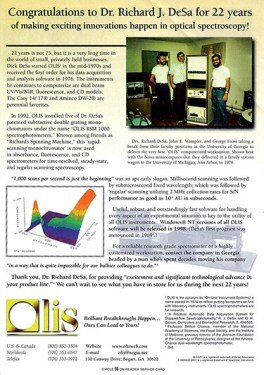Uv/vis/nir Fundamentals Explained
Uv/vis/nir Fundamentals Explained
Blog Article
Uv/vis for Beginners
Table of ContentsThe smart Trick of Uv/vis That Nobody is Talking AboutGetting My Circular Dichroism To WorkThe Spectrophotometers PDFsThe Only Guide for SpectrophotometersSome Known Facts About Circularly Polarized Luminescence.

Spectrophotometry is a tool that hinges on the quantitative analysis of particles depending on how much light is soaked up by colored compounds.
The Basic Principles Of Uv/vis/nir
A spectrophotometer is frequently used for the measurement of transmittance or reflectance of solutions, transparent or nontransparent solids, such as refined glass, or gases. Although many biochemicals are colored, as in, they soak up visible light and therefore can be measured by colorimetric procedures, even colorless biochemicals can frequently be converted to colored compounds appropriate for chromogenic color-forming reactions to yield substances suitable for colorimetric analysis.: 65 However, they can likewise be designed to measure the diffusivity on any of the listed light ranges that typically cover around 2002500 nm using various controls and calibrations.
An example of an experiment in which spectrophotometry is utilized is the determination of the equilibrium constant of a solution. A specific chain reaction within a solution might happen in a forward and reverse direction, where reactants form products and products break down into reactants. Eventually, this chemical response will reach a point of balance called a stability point.
Getting The Uv/vis To Work
The amount of light that travels through the service is a sign of the concentration of particular chemicals that do not enable light to pass through. The absorption of light is because of the interaction of light with the electronic and vibrational modes of particles. Each kind of particle has a specific set of energy levels related to the makeup of its chemical bonds and nuclei and therefore will absorb light of particular wavelengths, or energies, leading to special spectral homes.
They are extensively utilized in many industries consisting of semiconductors, laser and optical production, printing and forensic examination, as well as in labs for the study of chemical compounds. Spectrophotometry is frequently utilized in measurements of enzyme activities, determinations of protein concentrations, decisions of enzymatic kinetic constants, and measurements of ligand binding reactions.: 65 Ultimately, a spectrophotometer is able to figure out, depending on the control or calibration, what compounds are present in a target and exactly how much through calculations of observed wavelengths.
This would come as a service to the previously created spectrophotometers which were unable to take in the ultraviolet correctly.
What Does Circularly Polarized Luminescence Mean?
It would be found that this did not give satisfying results, therefore in Model B, there was a shift from a glass to a quartz prism which enabled better absorbance outcomes - UV/Vis (https://pagespeed.web.dev/analysis/https-olisclarity-com/ft59obxjpp?form_factor=mobile). From there, Model C was born with an adjustment to the wavelength resolution which wound up having 3 systems of it produced
It irradiates the sample with polychromatic light which the sample soaks up depending upon its properties. Then it is transmitted back by grating the photodiode selection which identifies the wavelength region of the spectrum. Ever since, the creation and implementation of spectrophotometry gadgets has actually increased exceptionally and has actually ended up being one of the most innovative instruments of our time.

The Facts About Spectrophotometers Uncovered
Historically, spectrophotometers utilize a monochromator including a diffraction grating to produce the analytical spectrum. The grating can either be movable or repaired. If a single detector, such as a photomultiplier tube or photodiode is used, the grating can be scanned stepwise (scanning spectrophotometer) so that the detector can determine the light intensity at each wavelength (which will represent each "action").
In such systems, the grating is fixed and the intensity of each wavelength of light is determined by a various detector in the variety. In addition, most modern-day mid-infrared spectrophotometers utilize a Fourier transform technique to get the spectral details - https://lwccareers.lindsey.edu/profiles/4273853-julie-ann-desa-lorenz. This method is called Fourier transform infrared spectroscopy. When making transmission measurements, the spectrophotometer quantitatively compares the portion of light that passes through a recommendation service and a test service, then digitally compares you can try these out the intensities of the 2 signals and calculates the portion of transmission of the sample compared to the recommendation standard.

Report this page